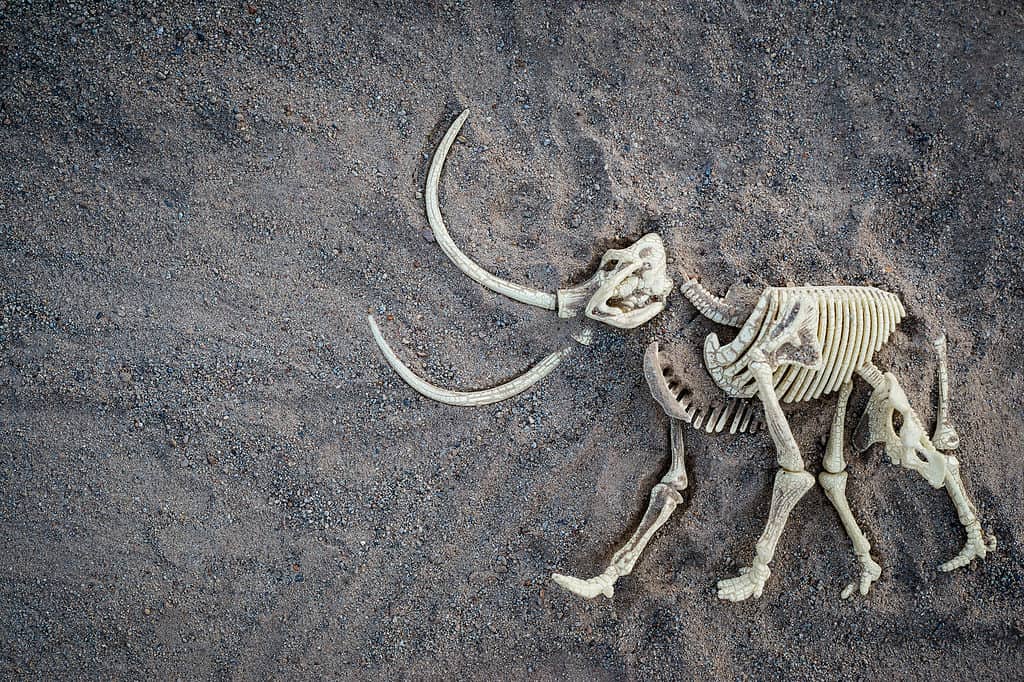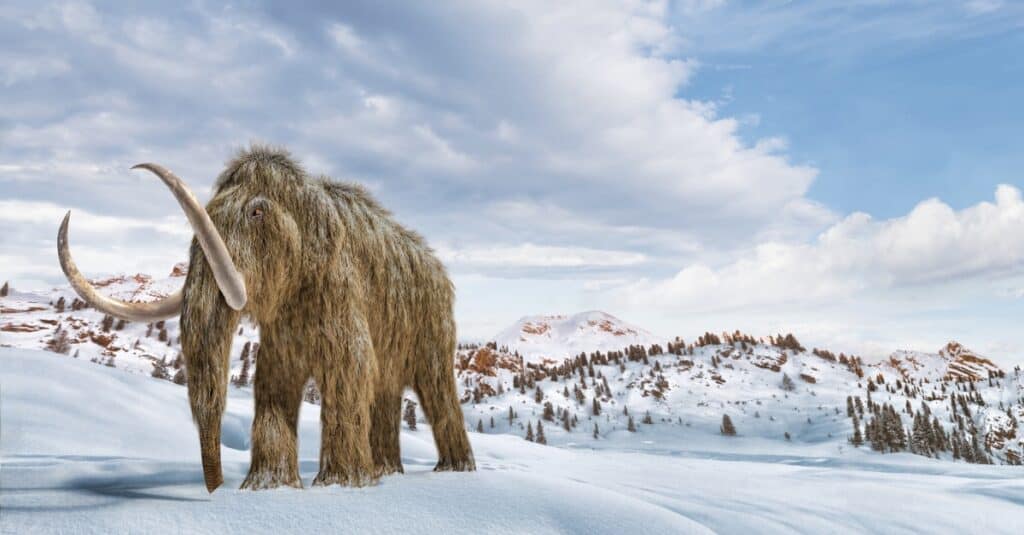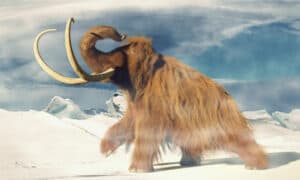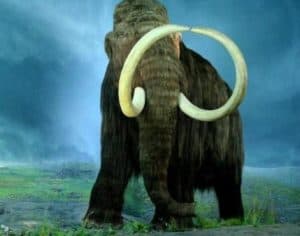Is it possible that woolly mammoths will make a comeback? As in, real-life, woolly mammoths once again walking the earth? Well, not quite, though the resurrection of one of the most fascinating animals to ever thunder across the earth looks more and more like a possibility.
The woolly mammoth is instantly recognizable, even though a living mammoth hasn’t drawn breath in over 4,000 years. As far as extinct species go, that’s not very long ago—a blip on the radar of Earth’s history.
Now, the aptly named Colossal Laboratories and Biosciences means to change all that and it looks like they’re hard work is about to pay off. How is this possible? Well, it’s complicated, has to do with genetic sequencing, and doesn’t mean we will one day see a perfect woolly mammoth. It would essentially be an entirely new species by taking the old and melding it with the new.
A Woolly Mammoth Hybrid
While the driving focus, from a public relations standpoint, is that woolly mammoths will make a comeback, that’s not entirely correct. The scientists at Colossal Laboratories and Biosciences aren’t cloning a mammoth inside a vat.
Colossal plans to utilize gene editing to create a mammoth embryo, which will then be implanted in an Asian elephant. Since the woolly mammoth has a 99.6% DNA match with the Asian elephant, it only makes sense. Plus, the size of the Asian elephant is large enough to give birth to its woolly cousin.
The reason the potential woolly mammoth is a hybrid is because of CRISPR-Cas9 DNA splicing. Scientists are splicing and fusing woolly mammoth DNA with Asian elephant DNA. The result will not be a perfect match with the woolly mammoths of old. The resulting “woolly mammoth” already has a new moniker—mammophant.
While this may be disappointing to those who want to see the giant, lumbering, hairy mammoths of millennia past, the result will be something so similar that the differences are negligible outside of a high-power microscope.
In other words, the resulting ‘mammophant’ from Colossal will be indistinguishable (in terms of visual observation) from a 5,000-year-old woolly mammoth.
Why Should Woolly Mammoths Make a Comeback?

Woolly mammoth skeleton.
©Lesterman/Shutterstock.com
There are two driving principles behind the idea of bringing back woolly mammoths. The first is humankind’s insistence on doing something just because they can. That’s always been the case and it’s the source of some of the greatest achievements in history and some of the worst tragedies.
The second is to save the permafrost in Arctic areas. In other words, Colossal believes that if woolly mammoths make a comeback, they will re-establish a nominal environment in the Earth’s coldest regions.
It is a laudable goal and the driving force behind it is the idea that thousands of trampling woolly mammoths will stomp permafrost back into the earth where it will quash the growth of new tree roots, effectively reducing the expansion of woodlands and, a side effect, more carbon in the atmosphere.
Not only that, the roots themselves produce carbon, and the woolly mammoth’s annual migration patterns would help keep those roots dead and under the ground. Or, at least, under layers of permafrost that will simultaneously repress carbon and kill the roots.
One thing is for certain, it would take a lot of mammoths to accomplish such a goal and they would have to move quite a bit.
Why Woolly Mammoths Shouldn’t Make a Comeback
The biggest argument against the woolly mammoth, or science’s closest iteration of one, is an ethical one. Opposing forces question the idea of bringing herds of woolly mammoths into a world where nature selected them for extinction.
The combination of playing God and combatting natural selection concerns many scientists just as much as it excites them. There’s also the issue of ignorance. Science can only inform us so much in terms of a massive animal whose last member is dead in the ground 4,000 years running.
The point is that scientists are voicing concern over the unknown. How will these animals behave? How will they affect their surrounding environment, much of which has never dealt with such an animal? Much of the vegetation that was around during the woolly mammoth’s time is no longer there either.
It’s well known that elephants retain much of their knowledge, understanding of their surrounding world, and instinctual reactions from their parents and other, adult elephants in their herd. The woolly mammoth will have no such luxury. It will only have an elephant mother that is not the same as a woolly mammoth.
Last but not least, the last woolly mammoth died with characteristics that made it a perfect fit for its ecosystem at the time. Although the north and south poles are cold places, fit for a woolly mammoth, they are not the same as they were 4,000 years ago.
Many of the creatures that live in areas through which new woolly mammoths would presumably migrate today. They live there because they have adapted to shifting environments, something woolly mammoths never had to do (because they’re all dead).
Colossal Aims for a 2027 Woolly Mammoth Resurrection

The woolly mammoth became extinct roughly 4,000 years ago.
©iStock.com/leonello
The timeline for bringing back the woolly mammoth is 2027. Some believe that this is far too short for such a precise science. The funding is certainly there, but perhaps the timing is a bit too optimistic.
According to Joseph Frederickson, a paleontologist at the Earth Museum in Wisconsin, “Is this going to happen anytime soon? The answer is not.”
He may be correct. The idea of bringing back the woolly mammoth is not a new one. Another issue Colossal is dealing with is a competitive one. Revive & Restore, a non-profit based in California is also trying to bring back the woolly mammoth.
Historically, competition is an incredibly effective, driving force towards innovation and success. It’s what put America on the moon ahead of the Russians. However, it also brought us several disasters. There are inherent dangers in rushing to be first, especially when it comes to bringing a 4,000-year-old giant back to life.
Final Thoughts
Will woolly mammoths make a comeback? Well, it seems like Colossal and Revive & Restore mean to see it happen sooner rather than later. While it’s an exciting prospect (who doesn’t want to see a real-life woolly mammoth in its natural environment?), there are some troubling aspects to think about as well.
There’s no doubt that it’s a fascinating idea and, barring some disastrous setback, Colossal is liable to see it happen, though maybe not as quickly as they wish. Perhaps, one day, we will witness these giant creatures thundering across a tundra once again. The last people to lay eyes on them were our ancestors, thousands of years ago.
We made it, but the woolly mammoth did not. Maybe that’s a warning or maybe it’s an indication that the woolly mammoth’s time was cut short. According to Colossal, we’ll soon find out, one way or the other.
The photo featured at the top of this post is © Dotted Yeti/Shutterstock.com
Thank you for reading! Have some feedback for us? Contact the AZ Animals editorial team.





